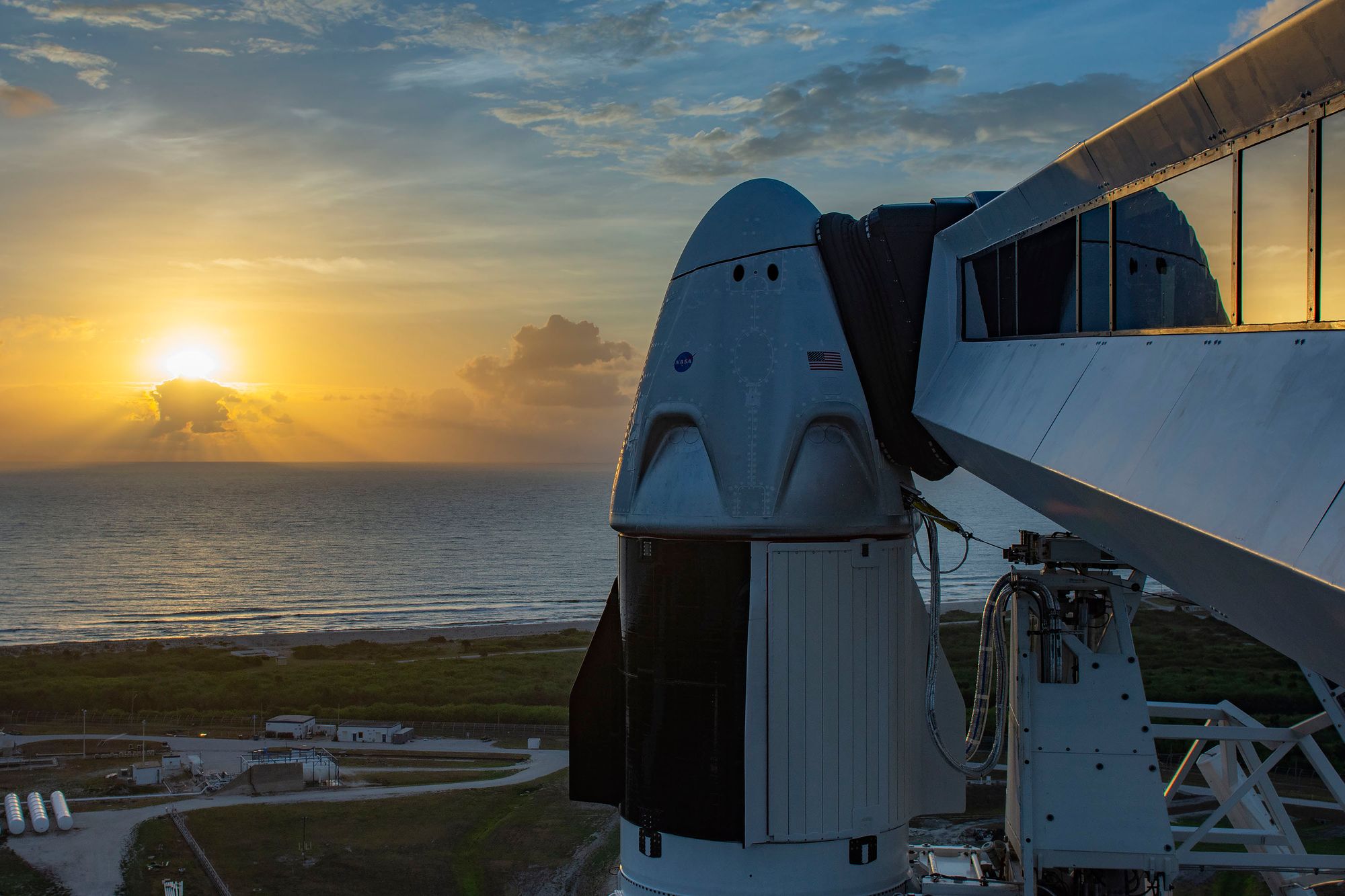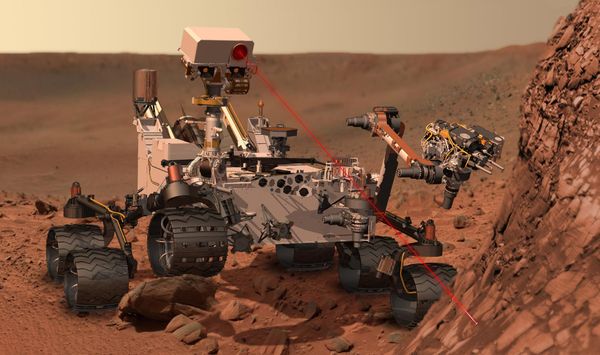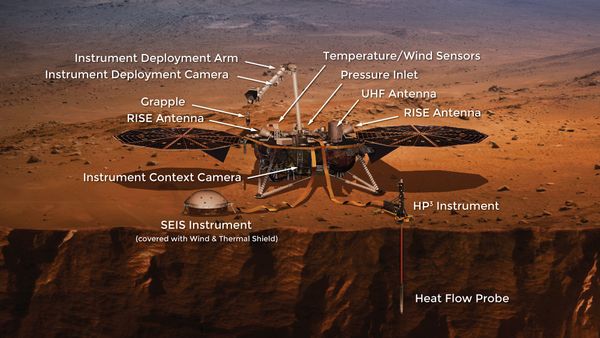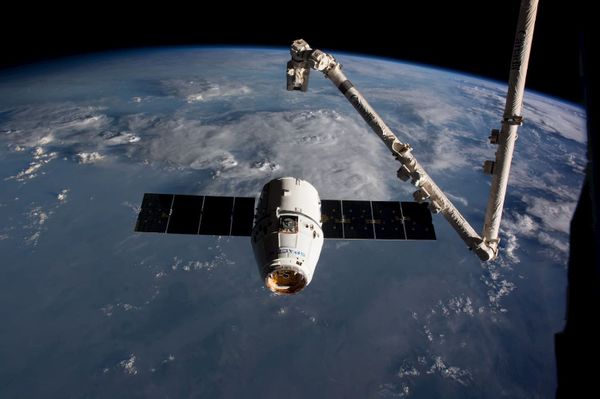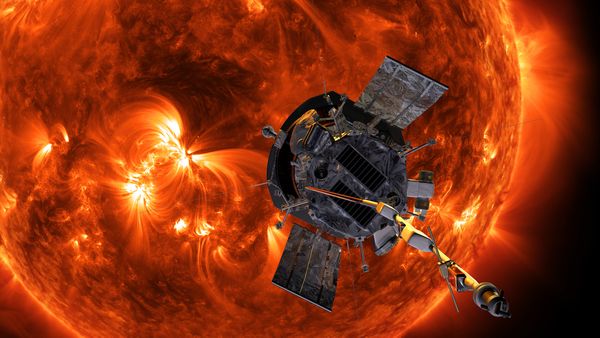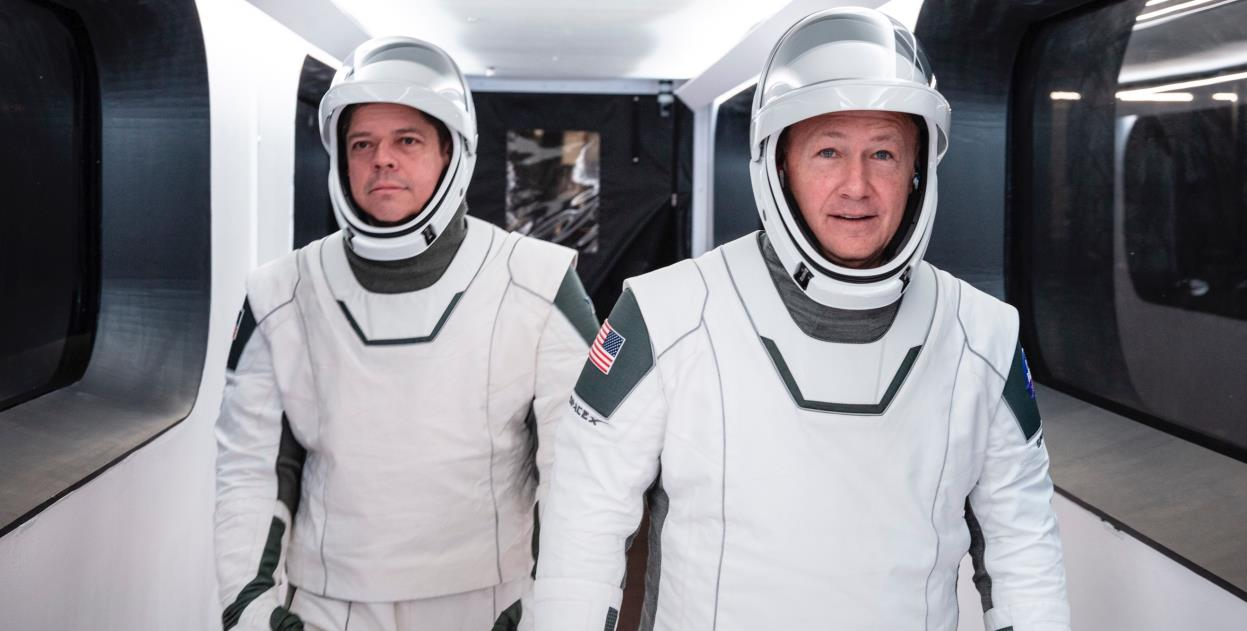
Update:
DM-2 has successfully launched on May 30th, 2020!
What is DM-2?
Demonstration Mission 2 (DM-2) is the first crewed flight of Crew Dragon. This test flight that will demonstrate the capabilities of the vehicle during launch, on-orbit rendezvous and docking with the International Space Station (ISS), and Entry, Descent, and Landing (EDL) with a crew on board. The mission is one of the last milestones in the Commercial Crew Transportation Capability (CCtCap) contract required for certification of the capsule for transportation of astronauts to and from the International Space Station (ISS).
Pre-launch Activities
The launch of DM-2 represents the culmination of over 10 years of research and development.
The Flight Readiness Review is the final technical review of the capsule before the flight. All aspects of the vehicle and launch system are reviewed and approved, including the procedures, the ground personnel will follow during the mission. Acting Associate Administrator for the Human Exploration Operations Mission Directorate, Ken Bowersox, gave SpaceX and Crew Dragon a "Go for Launch" on Friday, May 22rd after the two-day review.
Static fire of Falcon 9 complete – targeting Wednesday, May 27 at 4:33 p.m. EDT for Crew Dragon’s launch to the @Space_Station with @AstroBehnken and @Astro_Doug on board → https://t.co/bJFjLCzWdK pic.twitter.com/bhcTq4jxAr
— SpaceX (@SpaceX) May 22, 2020
SpaceX conducted a static fire test of the Falcon 9 booster core on May 22nd. This test involves fully fueling the rocket and conducting all steps of the launch sequence except for releasing the launch clamps holding the rocket to the pad.
The Dry Dress Rehearsal is like a static fire test for human astronauts. The crew fully prepare as if they were launching to space. They don their SpaceX flight suits, drive out to the launch pad in a Tesla Model X vehicle, and ride up the launch tower and board the spacecraft. The astronauts are able to practice everything they will do during the real launch day, without the risk of fuel in the rocket.
The Launch Readiness Review is the final review for the DM-2 launch. Key conditions for the launch like acceptable weather are discussed and reviewed. As of writing, the weather is 60% favorable for a launch on the 30th.
Countdown to Launch
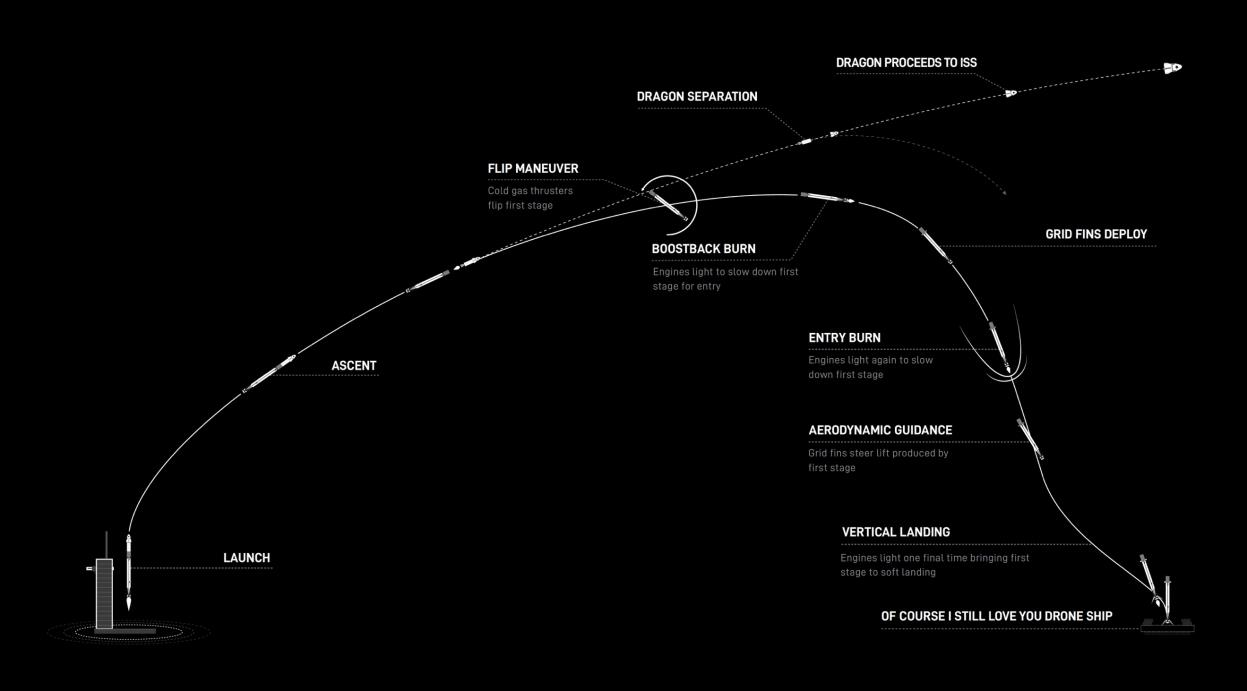
On launch day, Astronauts Bob Behnken and Doug Hurley will head out to Launch Pad 39A, the same pad that hosted the historic Apollo 11 launch that landed the first human on the surface of the moon. Liftoff is currently scheduled for 4:33 pm EST (20:33 UTC).
- -04:15:00 Crew weather brief -04:05:00 Crew handoff
- -04:00:00 Suit donning and checkouts
- -03:22:00 Crew Walk Out from Neil Armstrong Operations and Checkout Building
- -03:15:00 Crew Transportation to Launch Complex 39A
- -02:55:00 Crew arrives at pad
- -02:35:00 Crew ingress
- -02:20:00 Communication check
- -02:15:00 Verify ready for seat rotation
- -02:14:00 Suit leak checks
- -01:55:00 Hatch close
Once the crew has safely entered the capsule and completed their pre-launch checks, the Falcon 9 begins fueling.
Countdown Sequence
- -00:45:00 SpaceX Launch Director verifies go for propellant load
- -00:42:00 Crew access arm retracts
- -00:37:00 Dragon launch escape system is armed
- -00:35:00 RP-1 (rocket grade kerosene) loading begins
- -00:35:00 1st stage LOX (liquid oxygen) loading begins
- -00:16:00 2nd stage LOX loading begins
- -00:07:00 Falcon 9 begins engine chill prior to launch
- -00:05:00 Dragon transitions to internal power
- -00:01:00 Command flight computer to begin final prelaunch checks
- -00:01:00 Propellant tank pressurization to flight pressure begins
- -00:00:45 SpaceX Launch Director verifies go for launch
- -00:00:03 Engine controller commands engine ignition sequence to start
- -00:00:00 Falcon 9 liftoff
After the Falcon 9 has cleared the tower, the capsule undergoes a rapid series of events over the span of 12 minutes. The brand-new Falcon 9 booster will accelerate past the speed of sound, compressing the air in front of the rocket, until it reaches its maximum pressure under a minute into the flight. After just two and half minutes, the first stage will separate and begin the autonomous flight back down to Earth, landing on the Autonomous Spaceport Drone Ship (ASDS), Of Course, I Still Love You (OCISLY).
- +00:00:58 Max Q (moment of peak mechanical stress on the rocket)
- +00:02:33 1st stage main engine cutoff (MECO)
- +00:02:36 1st and 2nd stages separate
- +00:02:44 2nd stage engine starts
- +00:07:15 1st stage entry burn
- +00:08:47 2nd stage engine cutoff (SECO-1)
- +00:08:52 1st stage entry burn
- +00:09:22 1st stage landing
- +00:12:00 Crew Dragon separates from 2nd stage
- +00:12:46 Dragon nosecone open sequence begins
Rendezvous and Docking with the ISS
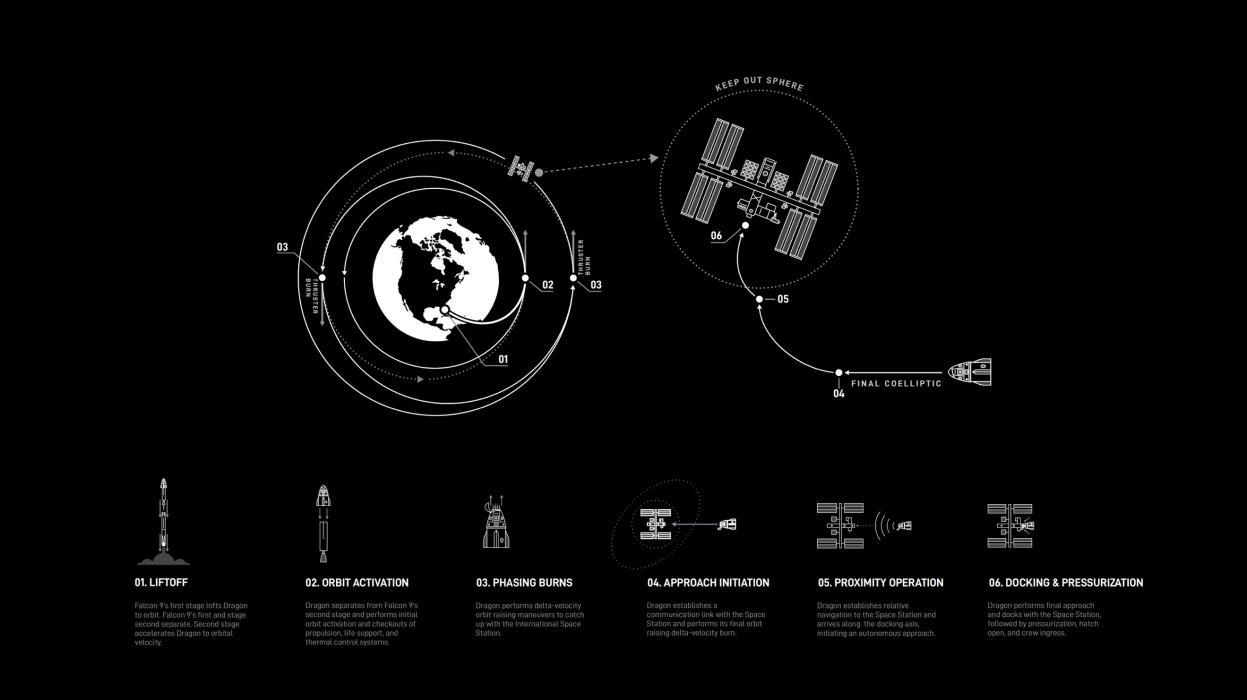
Once Crew Dragon enters orbit, it will begin the process of rendezvousing with the ISS. It will take roughly 18 hours and multiple subtle maneuvers for the two astronauts to arrive near the orbiting laboratory. The ISS has a 2o0m area known as the 'Keep Out Sphere' (KOS). Crew Dragon will arrive at the edge of this sphere and begin communicating with the station entirely autonomously. The astronauts will be standing by to observe and step in manually if any issue is encountered during the approach. The final approach from the last 200m is also autonomous, with Crew Dragon docking with the station via the International Docking Adaptor (IDA).
Once docked, the astronauts will be able to enter the station and join the four astronauts and cosmonauts currently living in space. Normal crew rotations to the ISS last 6 months. Since DM-2 is a test flight, the astronauts' stay will be much shorter. NASA has not said how long they will remain on board, but this Crew Dragon can remain docked for up to 110 days, and operational Crew Dragon flights could last up to 210 days. Bob Behnken and Doug Hurley have undergone extended training for Extra-Vehicular Activities (EVAs) aka spacewalks, and will likely conduct maintenance and scientific experiments during their stay at the station.
Entry, Descent, and Landing
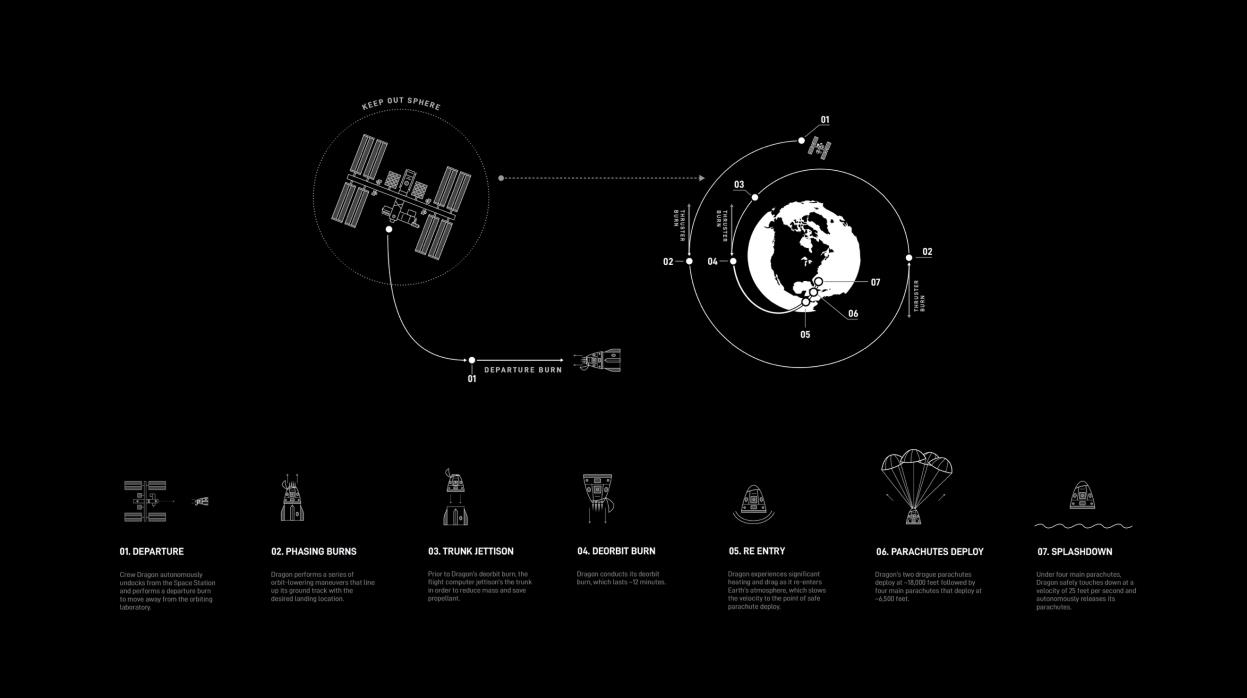
When it comes time to leave the station, Crew Dragon will perform the inverse of its docking maneuver, slowly backing away from the station and out of the KOS. The capsule landing zone is the waters just off the coast of Florida. The capsule will align itself on an orbital path that intersects the landing zone and then jettison its cargo trunk, which contains solar cells and space for unpressurized cargo on future missions. It will then conduct a deorbit burn lasting roughly 12 minutes which will slow the capsule down until it intersects the Earth's atmosphere. The high speed of the capsule and the blunt bottom will compress the air into super-heated gas. The heat shield will protect the craft and crew from the intense heat as the capsule slows down. Then four pairs parachutes will deploy to slow the capsule down for a gentle landing in the waters of the Atlantic ocean.
SpaceX has completed nearly 100 tests and flights of its Dragon parachute systems for cargo missions and in development of the upgraded Mark 3 design—one of the safest, most reliable parachute systems in the world for human spaceflight pic.twitter.com/WB8zm9ohBC
— SpaceX (@SpaceX) May 22, 2020
What comes next?
If DM-2 goes according to plan, SpaceX and NASA will have the data and practical validation required to certify Crew Dragon for regular flights to the ISS. NASA is planning Crew-1, the first operational 6-month crew rotation, No Earlier Than (NET) August 30th, 2020.
Crew Dragon represents the opening of orbital spaceflight to regular commercial service. Movie star Tom Cruise has begun plans to fly on Crew Dragon to the ISS to film an in-space motion picture.
NASA is excited to work with @TomCruise on a film aboard the @Space_Station! We need popular media to inspire a new generation of engineers and scientists to make @NASA’s ambitious plans a reality. pic.twitter.com/CaPwfXtfUv
— Jim Bridenstine (@JimBridenstine) May 5, 2020
Even more importantly, the success of the Commercial Crew Program validates the concept of commercial spaceflight development. NASA has partnered with commercial companies to deliver supplies to its new Lunar Gateway and recently awarded contracts to three commercial space companies to develop Human Landing Systems to land the first woman and next man on the surface of the Moon in 2024 as part of the Artemis program.

